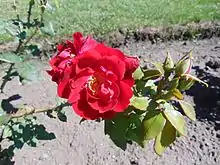Rosa × kordesii
Rosa × kordesii, or Rosa kordesii, is a red type of rose that arose naturally from hybridization followed by chromosome doubling. A hybrid between R. rugosa and R. lucieae was created called Rosa 'Max Graf', but it was diploid and nearly sterile, producing flowers but no fruit. This rose produced a few viable seeds as a result of self-pollination, and the seedlings that resulted were tetraploid instead of diploid, i.e., the chromosomes of both pollen and egg cells had been naturally duplicated. The tetraploid seedlings are amphidiploids.[1] A selection with double deep pink flowers and repeat bloom, also called 'K01 AgCan' was released by W. Kordes' Söhne in 1951.[2]
| Rosa × kordesii | |
|---|---|
 | |
| Rosa × kordesii 'L 15', one of several garden roses produced with the same parentage | |
| Scientific classification | |
| Kingdom: | Plantae |
| Clade: | Tracheophytes |
| Clade: | Angiosperms |
| Clade: | Eudicots |
| Clade: | Rosids |
| Order: | Rosales |
| Family: | Rosaceae |
| Genus: | Rosa |
| Species: | R. × kordesii |
| Binomial name | |
| Rosa × kordesii H.Wulff | |
.jpg.webp)
These tetraploid roses interbreed readily with one another, but not with their diploid ancestors. Under the biological species concept, a new species name Rosa × kordesii was created for the tetraploid hybrid roses and their descendants.[3]
Amphidiploid roses can also be created deliberately from diploid-diploid hybrids by using colchicine spray on the growing tips of the plants. That strategy gives few successes, however, because the plant tissue has various chromosome numbers in different cells.[1] Amphidiploid roses including Rosa × kordesii have been used to some degree in breeding programs in combination with naturally occurring tetraploid roses.[1]
Uses
Rosa × kordesii petal extract gel is stable for at least 3–4 months when stored at 5 and 25 °C. It is essential for collection of similar data for different plants and their flowers, as well as other parts. This proved activity of plant showed its importance and prophylactic utility in anti-solar formulation. This will be a better, cheaper and safe alternative to harmful chemical sunscreens that used nowadays in the industry.[4]
References
- Janick, J. (2010), Plant Breeding Reviews, Wiley, ISBN 9780470650127 page 176
- Rosa kordesii H. Wulff rose Description, Helpmefind.com, retrieved 13 November 2015
- Wulff, H.D. (1951), "Rosa Kordesii, eine neue amphidiploide Rose", Der Züchter, 21 (4–5): 123–132, doi:10.1007/BF00709566, S2CID 33505669
- Sachin G. Lokapure (2013), "In vitro determination of sun protection factor and chemical stability of Rosa kordesii extract gel", Journal of Pharmacy Research, 7 (6): 520–524, doi:10.1016/j.jopr.2013.05.021